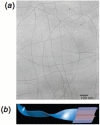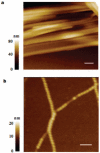Molecular self-assembly into one-dimensional nanostructures
- PMID: 18754628
- PMCID: PMC2645948
- DOI: 10.1021/ar8000926
Molecular self-assembly into one-dimensional nanostructures
Abstract
Self-assembly of small molecules into one-dimensional nanostructures offers many potential applications in electronically and biologically active materials. The recent advances discussed in this Account demonstrate how researchers can use the fundamental principles of supramolecular chemistry to craft the size, shape, and internal structure of nanoscale objects. In each system described here, we used atomic force microscopy (AFM) and transmission electron microscopy (TEM) to study the assembly morphology. Circular dichroism, nuclear magnetic resonance, infrared, and optical spectroscopy provided additional information about the self-assembly behavior in solution at the molecular level. Dendron rod-coil molecules self-assemble into flat or helical ribbons. They can incorporate electronically conductive groups and can be mineralized with inorganic semiconductors. To understand the relative importance of each segment in forming the supramolecular structure, we synthetically modified the dendron, rod, and coil portions. The self-assembly depended on the generation number of the dendron, the number of hydrogen-bonding functions, and the length of the rod and coil segments. We formed chiral helices using a dendron-rod-coil molecule prepared from an enantiomerically enriched coil. Because helical nanostructures are important targets for use in biomaterials, nonlinear optics, and stereoselective catalysis, researchers would like to precisely control their shape and size. Tripeptide-containing peptide lipid molecules assemble into straight or twisted nanofibers in organic solvents. As seen by AFM, the sterics of bulky end groups can tune the helical pitch of these peptide lipid nanofibers in organic solvents. Furthermore, we demonstrated the potential for pitch control using trans-to-cis photoisomerization of a terminal azobenzene group. Other molecules called peptide amphiphiles (PAs) are known to assemble in water into cylindrical nanostructures that appear as nanofiber bundles. Surprisingly, TEM of a PA substituted by a nitrobenzyl group revealed assembly into quadruple helical fibers with a braided morphology. Upon photocleavage of this the nitrobenzyl group, the helices transform into single cylindrical nanofibers. Finally, inspired by the tobacco mosaic virus, we used a dumbbell-shaped, oligo(phenylene ethynylene) template to control the length of a PA nanofiber self-assembly (<10 nm). AFM showed complete disappearance of long nanofibers in the presence of this rigid-rod template. Results from quick-freeze/deep-etch TEM and dynamic light scattering demonstrated the templating behavior in aqueous solution. This strategy could provide a general method to control size the length of nonspherical supramolecular nanostructures.
Figures












References
-
- Bain CD, Whitesides GM. Molecular-Level Control over Surface Order in Self-Assembled Monolayer Films of Thiols on Gold. Science. 1988;240(4848):62–63. - PubMed
-
- Nuzzo RG, Fusco FA, Allara DL. Spontaneously Organized Molecular Assemblies. 3. Preparation and Properties of Solution Adsorbed Monolayers of Organic Disulfides on Gold Surfaces. J. Am. Chem. Soc. 1987;109(8):2358–2368.
-
- Tanase M, Silevitch DM, Hultgren A, Bauer LA, Searson PC, Meyer GJ, Reich DH. Magnetic Trapping and Self-Assembly of Multicomponent Nanowires. J. Appl. Phys. 2002;91:8549–8551.
-
- Smith PA, Nordquist CD, Jackson TN, Mayer TS, Martin BR, Mbindyo J, Mallouk TE. Electric-Field Assisted Assembly and Alignment of Metallic Nanowires. Appl. Phys. Lett. 2000;77:1399–1401.
-
- Huang Y, Duan X, Wei Q, Lieber CM. Directed Assembly of One-Dimensional Nanostructures into Functional Networks. Science. 2001;291(5504):630–633. - PubMed
Publication types
MeSH terms
Substances
Grants and funding
LinkOut - more resources
Full Text Sources
Other Literature Sources
Research Materials
Miscellaneous

